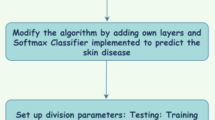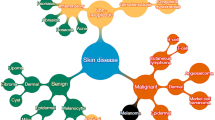Abstract
Purpose
The purpose of this study was to develop a deep learning-based computer-aided diagnosis system for skin disease classification using photographic images of patients. The targets are 59 skin diseases, including localized and diffuse diseases captured by photographic cameras, resulting in highly diverse images in terms of the appearance of the diseases or photographic conditions.
Methods
ResNet-18 is used as a baseline model for classification and is reinforced by metric learning to boost generalization in classification by avoiding the overfitting of the training data and increasing the reliability of CADx for dermatologists. Patient-wise classification is performed by aggregating the inference vectors of all the input patient images.
Results
The experiment using 70,196 images of 13,038 patients demonstrated that classification accuracy was significantly improved by both metric learning and aggregation, resulting in patient accuracies of 0.579 for Top-1, 0.793 for Top-3, and 0.863 for Top-5. The McNemar test showed that the improvements achieved by the proposed method were statistically significant.
Conclusion
This study presents a deep learning-based classification of 59 skin diseases using multiple photographic images of a patient. The experimental results demonstrated that the proposed classification reinforced by metric learning and aggregation of multiple input images was effective in the classification of patients with diverse skin diseases and imaging conditions.







Similar content being viewed by others
Change history
05 August 2021
Red words and red numerals were present in table 1 and these have been changed to black text.
References
Griffiths C, Barker J, Bleiker T, Chalmers R, Creamer D (2016) Rook's textbook of dermatology. Wiley-Blackwell
Codella NCF, Gutman D, Celebi ME, Helba B, Marchetti MA, Dusza SW, Kalloo A, Liopyris K, Mishra N, Kittler H, Halpern A (2018) Skin lesion analysis toward melanoma detection: a challenge. In: The 2017 International symposium on biomedical imaging (ISBI), hosted by the international skin imaging collaboration (ISIC). 2018 IEEE 15th international symposium on biomedical imaging (ISBI 2018), pp 168–172. https://doi.org/10.1109/ISBI.2018.8363547
Codella N, Rotemberg V, Tschandl P, Celebi ME, Dusza S, Gutman D, Helba B, Kalloo A, Liopyris K, Marchetti M, Kittler H, Halpern A (2019) Skin lesion analysis toward melanoma detection 2018: a challenge hosted by the international skin imaging collaboration (ISIC)
Esteva A, Kuprel B, Novoa RA, Ko J, Swetter SM, Blau HM, Thrun S (2017) Dermatologist-level classification of skin cancer with deep neural networks. Nature 542:115–118. https://doi.org/10.1038/nature21056
Fujisawa Y, Otomo Y, Ogata Y, Nakamura Y, Fujita R, Ishitsuka Y, Watanabe R, Okiyama N, Ohara K, Fujimoto M (2019) Deep-learning-based, computer-aided classifier developed with a small dataset of clinical images surpasses board-certified dermatologists in skin tumour diagnosis. Br J Dermatol 180(2):373–381. https://doi.org/10.1111/bjd.16924
Tschandl P, Rosendahl C, Akay BN, Argenziano G, Blum A, Braun RP, Cabo H, Gourhant JY, Kreusch J, Lallas A, Lapins J, Marghoob A, Menzies S, Neuber NM, Paoli J, Rabinovitz HS, Rinner C, Scope A, Soyer PH, Sinz C, Thomas L, Zalaudek I, Kittler H (2019) Expert-Level Diagnosis of nonpigmented skin cancer by combined convolutional neural networks. JAMA Dermatol 155(1):58–65. https://doi.org/10.1001/jamadermatol.2018.4378
Dorj UO, Lee KK, Choi JY, Lee M (2018) The skin cancer classification using deep convolutional neural network. Multimedia Tools Appl 77:9909–9924. https://doi.org/10.1007/s11042-018-5714-1
Han SS, Kim MS, Lim W, Park GH, Park I, Chang SE (2018) Classification of the clinical images for benign and malignant cutaneous tumors using a deep learning algorithm. J Investig Dermatol 138(7):1529–1538. https://doi.org/10.1016/j.jid.2018.01.028
Harangi B (2018) Skin lesion classification with ensembles of deep convolutional neural networks. J Biomed Inform 86:25–32. https://doi.org/10.1016/j.jbi.2018.08.006
Wei D, Cao S, Ma K, Zheng Y (2020) Learning and exploiting interclass visual correlations for medical image classification. Med Image Comput Comput Assist Interv 12261:106–115. https://doi.org/10.1007/978-3-030-59710-8_11
Yap J, Yolland W, Tschandl P (2018) Multimodal skin lesion classification using deep learning. Exp Dermatol 27(11):1261–1267. https://doi.org/10.1111/exd.13777
Tschandl P, Rosendahl C, Kittler H (2018) The HAM10000 dataset, a large collection of multi-source dermatoscopic images of common pigmented skin lesions. Sci Data 5:180161. https://doi.org/10.1038/sdata.2018.161
Szegedy C, Vanhoucke V, Ioffe S, Shlens J, Wojna Z (2016) Rethinking the inception architecture for computer vision. IEEE Conf Comput Vis Pattern Recognit (CVPR) 2016:2818–2826. https://doi.org/10.1109/CVPR.2016.308
Szegedy C, Liu W, Jia Y, Sermanet P, Reed S, Anguelov D, Erhan D, Vanhoucke V, Rabinovich A (2015) Going deeper with convolutions. IEEE Conf Comput Vis Pattern Recognit (CVPR) 2015:1–9. https://doi.org/10.1109/CVPR.2015.7298594
Schroff F, Kalenichenko D, Philbin J (2015) FaceNet: a unified embedding for face recognition and clustering. IEEE Conf Comput Vis Pattern Recognit (CVPR) 2015:815–823. https://doi.org/10.1109/CVPR.2015.7298682
Deng J, Guo J, Xue N, Zafeiriou S (2019) ArcFace: additive angular margin loss for deep face recognition. IEEE/CVF Conf Comput Vis Pattern Recognit (CVPR) 2019:4685–4694. https://doi.org/10.1109/CVPR.2019.00482
Santi P, Irina S, Matt R (2019) Few-shot learning with deep triplet networks for brain imaging modality recognition. Int Worksh Med Image Learn Less Labels Imperfect Data 11795:181–189. https://doi.org/10.1007/978-3-030-33391-1_21
He K, Zhang X, Ren S, Sun J (2016) Deep residual learning for image recognition. IEEE Conf Comput Vis Pattern Recognit (CVPR) 2016:770–778. https://doi.org/10.1109/CVPR.2016.90
Ioffe S, Szegedy C (2015) Batch normalization: accelerating deep network training by reducing internal covariate shift. In: Proceedings of the 32nd international conference on machine learning, vol 37, pp 448–456
Russakovsky O, Deng J, Su H, Krause J, Satheesh S, Ma S, Huang Z, Karpathy A, Khosla A, Bernstein M, Berg AC, Fei-Fei L (2015) ImageNet large scale visual recognition challenge. Int J Comput Vis 115:211–225. https://doi.org/10.1007/s11263-015-0816-y
He K, Zhang X, Ren S, Sun J (2015) Delving deep into rectifiers: surpassing human-level performance on ImageNet classification. In: Proceedings of the IEEE international conference on computer vision (ICCV), pp 1026–1034
Kingma DP, Ba JL (2015) Adam: a method for stochastic optimization. In: 3rd International conference on learning representations (ICLR)
Zhou B, Khosla A, Lapedriza A, Oliva A, Torralba A (2016) Learning deep features for discriminative localization. In: Proceedings of the IEEE conference on computer vision and pattern recognition (CVPR), pp 2921–2929
Acknowledgements
This research is supported in part by the ICT infrastructure establishment and implementation of artificial intelligence for clinical and medical research from the Japan Agency for Medical Research and Development, AMED, JP20lk1010036.
Author information
Authors and Affiliations
Corresponding author
Ethics declarations
Conflict of interests
The authors declare that they have no conflict of interest.
Ethical approval
This manuscript has not been published elsewhere and is not under consideration for publication in any other journal. All authors have approved the manuscript and agree with its submission to IJCARS. All procedures in this study involving human participants were performed in accordance with the ethical standards of the institutional research committees and the 1975 Helsinki Declaration (as revised in 2008(5)).
Additional information
Publisher's Note
Springer Nature remains neutral with regard to jurisdictional claims in published maps and institutional affiliations.
Appendix
Appendix
Confusion matrices of the image classification results at Levels 1, 2, and 3 of the taxonomy-tree. The darker the color of the cell, the higher the number of image classifications (Fig.
8).
Rights and permissions
About this article
Cite this article
Tanaka, M., Saito, A., Shido, K. et al. Classification of large-scale image database of various skin diseases using deep learning. Int J CARS 16, 1875–1887 (2021). https://doi.org/10.1007/s11548-021-02440-y
Received:
Accepted:
Published:
Issue Date:
DOI: https://doi.org/10.1007/s11548-021-02440-y





